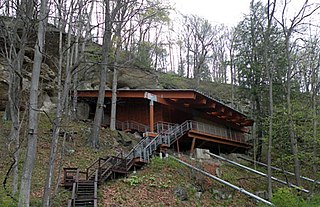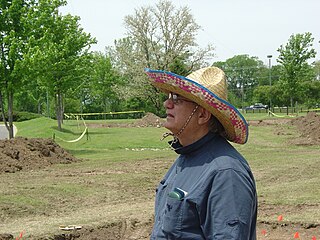Juliet Morrow is an American archaeologist and a professor of Anthropology at Arkansas State University in Jonesboro, Arkansas. [1]
Juliet Morrow is an American archaeologist and a professor of Anthropology at Arkansas State University in Jonesboro, Arkansas. [1]
Morrow was born in St. Louis, Missouri on April 5, 1962. She graduated from Washington University in St. Louis with BA degrees in geology and anthropology in 1987. She went on to receive an MA (1990) and a Ph.D. (1996) in anthropology from Washington University in St. Louis as well. In 1998 she founded the Central Mississippi Valley Archaeological Society.

In the History of Mesoamerica, the stage known as the Paleo-Indian period is the era in the scheme of Mesoamerican chronology which begins with the very first indications of human habitation within the Mesoamerican region, and continues until the general onset of the development of agriculture and other proto-civilisation traits. The conclusion of this stage may be assigned to approximately 9000 BP, and the transition to the succeeding Archaic period is not a well-defined one.

Clovis points are the characteristically fluted projectile points associated with the New World Clovis culture, a prehistoric Paleo-American culture. They are present in dense concentrations across much of North America and they are largely restricted to the north of South America. There are slight differences in points found in the Eastern United States bringing them to sometimes be called "Clovis-like". Clovis points date to the Early Paleoindian period, with all known points dating from roughly 13,400–12,700 years ago. As an example, Clovis remains at the Murry Springs Site date to around 12,900 calendar years ago. Clovis fluted points are named after the city of Clovis, New Mexico, where examples were first found in 1929 by Ridgely Whiteman.

The Clovis culture is an archaeological culture from the Paleoindian period of North America, spanning around 13,050 to 12,750 years Before Present (BP). The type site is Blackwater Draw locality No. 1 near Clovis, New Mexico, where stone tools were found alongside the remains of Columbian mammoths in 1929. Clovis sites have been found across North America. The most distinctive part of the Clovis culture toolkit are Clovis points, which are projectile points with a fluted, lanceolate shape. Clovis points are typically large, sometimes exceeding 10 centimetres (3.9 in) in length. These points were multifunctional, also serving as cutting tools. Other stone tools used by the Clovis culture include knives, scrapers, and bifacial tools, with bone tools including beveled rods and shaft wrenches, with possible ivory points also being identified. Hides, wood, and natural fibers may also have been utilized, though no direct evidence of this has been preserved. Clovis artifacts are often found grouped together in caches where they had been stored for later retrieval, and over 20 Clovis caches have been identified.
Topper is an archaeological site located along the Savannah River in Allendale County, South Carolina, United States. It is noted as a location of artifacts which some archaeologists believe to indicate human habitation of the New World earlier than the Clovis culture. The latter were previously believed to be the first people in North America.

Paleo-Indians were the first peoples who entered and subsequently inhabited the Americas towards the end of the Late Pleistocene period. The prefix paleo- comes from the Ancient Greek adjective: παλαιός, romanized: palaiós, lit. 'old; ancient'. The term Paleo-Indians applies specifically to the lithic period in the Western Hemisphere and is distinct from the term Paleolithic.

The Meadowcroft Rockshelter is an archaeological site which is located near Avella in Jefferson Township, Pennsylvania. The site is a rock shelter in a bluff overlooking Cross Creek, and contains evidence that the area may have been continually inhabited for more than 19,000 years. If accurately dated, it would be one of the earliest known sites with evidence of a human presence and continuous human occupation in the New World.

The Solutrean hypothesis on the peopling of the Americas is the claim that the earliest human migration to the Americas began from Europe during the Solutrean Period, with Europeans traveling along pack ice in the Atlantic Ocean. This hypothesis contrasts with the mainstream academic narrative that the Americas were populated first by people crossing the Bering Strait to Alaska by foot on what was land during the Last Glacial Period or by following the Pacific coastline from Asia to America by boat.
David G. Anderson is an archaeologist in the department of anthropology at the University of Tennessee, Knoxville, who specializes in Southeastern archaeology. His professional interests include climate change and human response, exploring the development of cultural complexity in Eastern North America, maintaining and improving the nation's Cultural Resource management (CRM) program, teaching and writing about archaeology, and developing technical and popular syntheses of archaeological research. He is the project director of the on-line Paleoindian Database of the Americas (PIDBA). and a co-director, with Joshua J. Wells, Eric C, Kansa, and Sarah Whitcher Kansa, of the Digital Index of North American Archaeology (DINAA)

Blackwater Draw is an intermittent stream channel about 140 km (87 mi) long, with headwaters in Roosevelt County, New Mexico, about 18 km (11 mi) southwest of Clovis, New Mexico, and flows southeastward across the Llano Estacado toward the city of Lubbock, Texas, where it joins Yellow House Draw to form Yellow House Canyon at the head of the North Fork Double Mountain Fork Brazos River. It stretches across eastern Roosevelt County, New Mexico, and Bailey, Lamb, Hale, and Lubbock Counties of West Texas and drains an area of 1,560 sq mi (4,040 km2).

The archaeology of Iowa is the study of the buried remains of human culture within the U.S. state of Iowa from the earliest prehistoric through the late historic periods. When the American Indians first arrived in what is now Iowa more than 13,000 years ago, they were hunters and gatherers living in a Pleistocene glacial landscape. By the time European explorers visited Iowa, American Indians were largely settled farmers with complex economic, social, and political systems. This transformation happened gradually. During the Archaic period American Indians adapted to local environments and ecosystems, slowly becoming more sedentary as populations increased. More than 3,000 years ago, during the Late Archaic period, American Indians in Iowa began utilizing domesticated plants. The subsequent Woodland period saw an increase on the reliance on agriculture and social complexity, with increased use of mounds, ceramics, and specialized subsistence. During the Late Prehistoric period increased use of maize and social changes led to social flourishing and nucleated settlements. The arrival of European trade goods and diseases in the Protohistoric period led to dramatic population shifts and economic and social upheaval, with the arrival of new tribes and early European explorers and traders. During the Historical period European traders and American Indians in Iowa gave way to American settlers and Iowa was transformed into an agricultural state.
Vance T. Holliday is a professor in the School of Anthropology and the department of Geosciences as well as an adjunct professor in the department of Geography at the University of Arizona in Tucson.
The Paleoindian Database of the Americas (PIDBA), is a website dedicated to the compilation of projectile point and other relevant data pertaining to Paleoindian site assemblages across the Americas. As of April 2011, the PIDBA database contains information pertaining to locational data (n=29,393), attribute data (n=15,254), and image data on Paleoindian projectile points and other tools in North America and also includes bibliographic references, radiocarbon dates, and maps created making use of database and GIS data. The PIDBA site provides a database that is useful in studying stylistic and morphological variability, lithic raw material usage and procurement strategies, geographic distributions of technology, and land use strategies during the Paleoindian period, which took place prior to ca. 11,450 cal year BP. The PIDBA database also serves a function as an intermediary between academic and advocational archaeologists in the collection and integration of primary projectile point data. Overall, the PIDBA project aims to compile data from multiple sources into a comprehensive database, while simultaneously seeking out and including new data. The PIDBA website contains a large amount of primary data collected and donated by researchers and advocational archaeologists from all over the Americas ranging from metric measurements to the type of chert any particular piece is made from. It is the voluntary contributions of primary data from these researchers that makes PIDBA possible. While it is understandable that researchers would like to fully examine and publish on their data, the site's philosophy is that it is important to disseminate information freely, so that other researchers can work with it. This allows researchers to make new discoveries that they perhaps would not be possible otherwise.

John Bertram Broster is an American archaeologist formerly serving as the Prehistoric Archeological Supervisor at the Tennessee Division of Archaeology, Department of Environment and Conservation. He is best known for his work on the Paleoindian period of the American Southwest and Southeast, and has published some 38 book chapters and journal articles on the subject.

The Gault archaeological site is an extensive, multicomponent site located in Florence, Texas, United States on the Williamson-Bell County line along Buttermilk Creek about 250 meters upstream from the Buttermilk Creek complex. It bears evidence of human habitation for at least 20,000 years, making it one of the few archaeological sites in the Americas at which compelling evidence has been found for human occupation dating to before the appearance of the Clovis culture. Archaeological material covers about 16 hectares with a depth of up to 3 meters in places. About 30 incised stones from the Clovis period engraved with geometric patterns were found there as well as others from periods up to the Early Archaic. Incised bone was also found.
The Anzick site (24PA506), located adjacent to Flathead Creek, a tributary of the Shields River in Wilsall, Park County, Montana, United States, is the only known Clovis burial site in the New World. The term "Clovis" is used by archaeologists to define one of the New World's earliest hunter-gatherer cultures and is named after the site near Clovis, New Mexico, where human artifacts were found associated with the procurement and processing of mammoth and other large and small fauna.
Anzick-1 was a young Paleoindian child whose remains were found in south central Montana, United States, in 1968. He has been dated to 12,990–12,840 years Before Present. The child was found with more than 115 tools made of stone and antlers and dusted with red ocher, suggesting a deliberate burial. Anzick-1 is the only human whose remains are associated with the Clovis culture, and is the first ancient Native American genome to be fully sequenced.
The Quad site is a series of Paleoindian sites and localities in Limestone County near Decatur, Alabama. It was first reported by Frank Soday in 1954, and later findings were also documented by James Cambron, David Hulse and Joe Wright and Cambron and Hulse. The Quad Locale can seldom be viewed at current lake levels, even during normal winter pool, due to extensive erosion, but is considered one of the most important and well known Paleoindian sites in the Southeastern United States.

Paleo Crossing site, also known as the Old Dague Farm site, is an archaeological site near Sharon Center, Ohio in Medina County where Clovis artifacts dated to 10,980 BP ± 75 years Before Present were found. The Cleveland Museum of Natural History conducted an excavation from 1990 to 1993. The site provides evidence of Paleo-Indians in northern Ohio and may be the area's oldest residents and archaeologist Dr. David Brose believes that they may be "some of the oldest certain examples of human activity in the New World." The site contains charcoal recovered from refuse pits. There were also two post holes and blades and tools 80% of which were made from flint from the Ohio River Valley in Indiana, 500 miles from Paleo Crossing, which indicates that the hunter-gatherers had a widespread social network and traveled across distances relatively quickly. The post holes are evidence that there was a shelter built on the site.

David Jeffrey Meltzer is an American archaeologist known for his influential studies of Paleo-Indians and Pleistocene mammalian extinction in the Americas. He is currently Henderson-Morrison Professor of Prehistory at Southern Methodist University and Affiliate Professor at the Centre for GeoGenetics at the University of Copenhagen.

Fishtail points, also known as Fell points are a style of Paleoindian projectile point widespread across much of South America at the end of the Late Pleistocene, around 13-12,000 years ago. They are thought to have been mutlifunctional, serving as cutting tools, as well as hafted to spears to use as hunting weapons, possibly in combination with spear throwers.